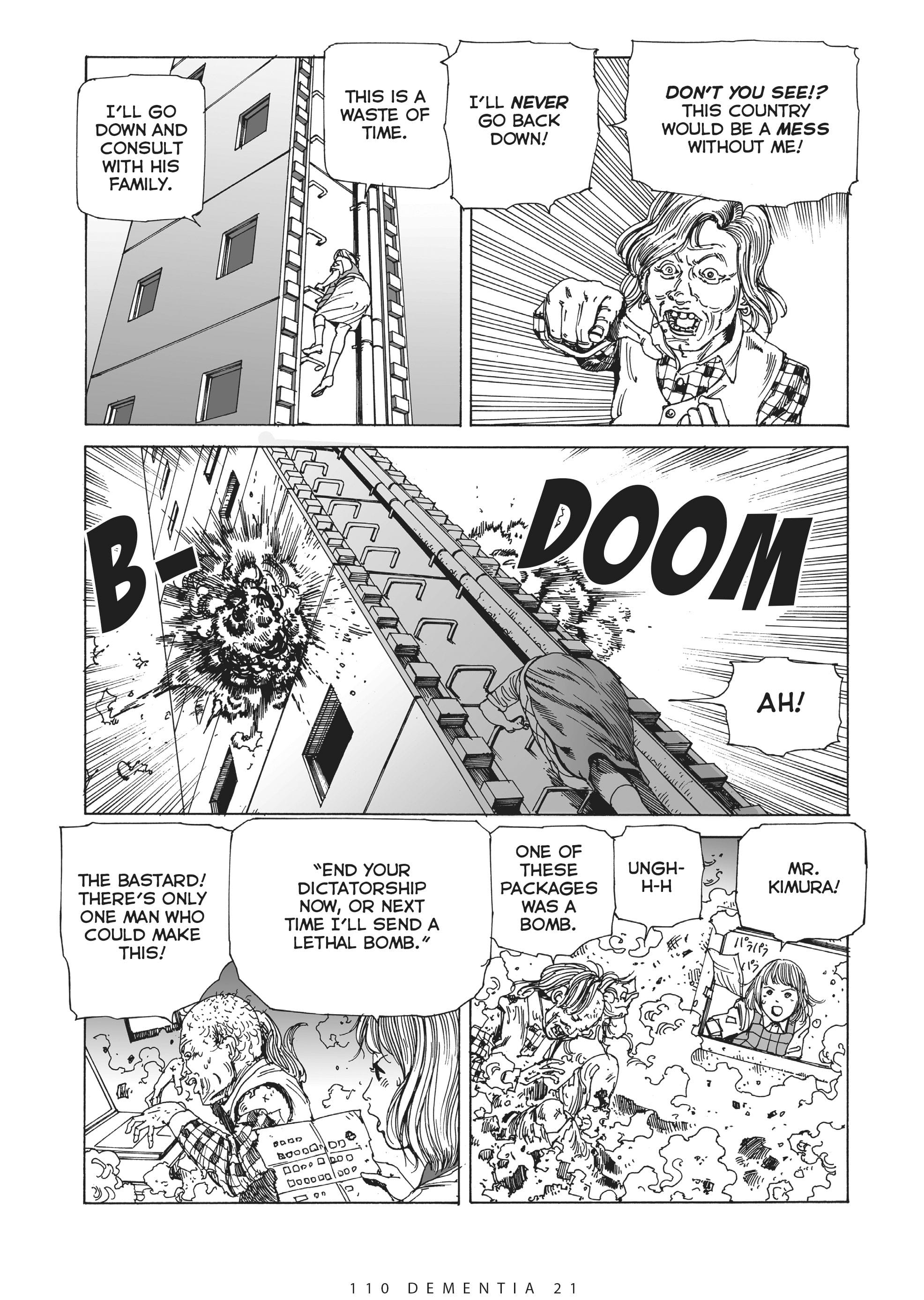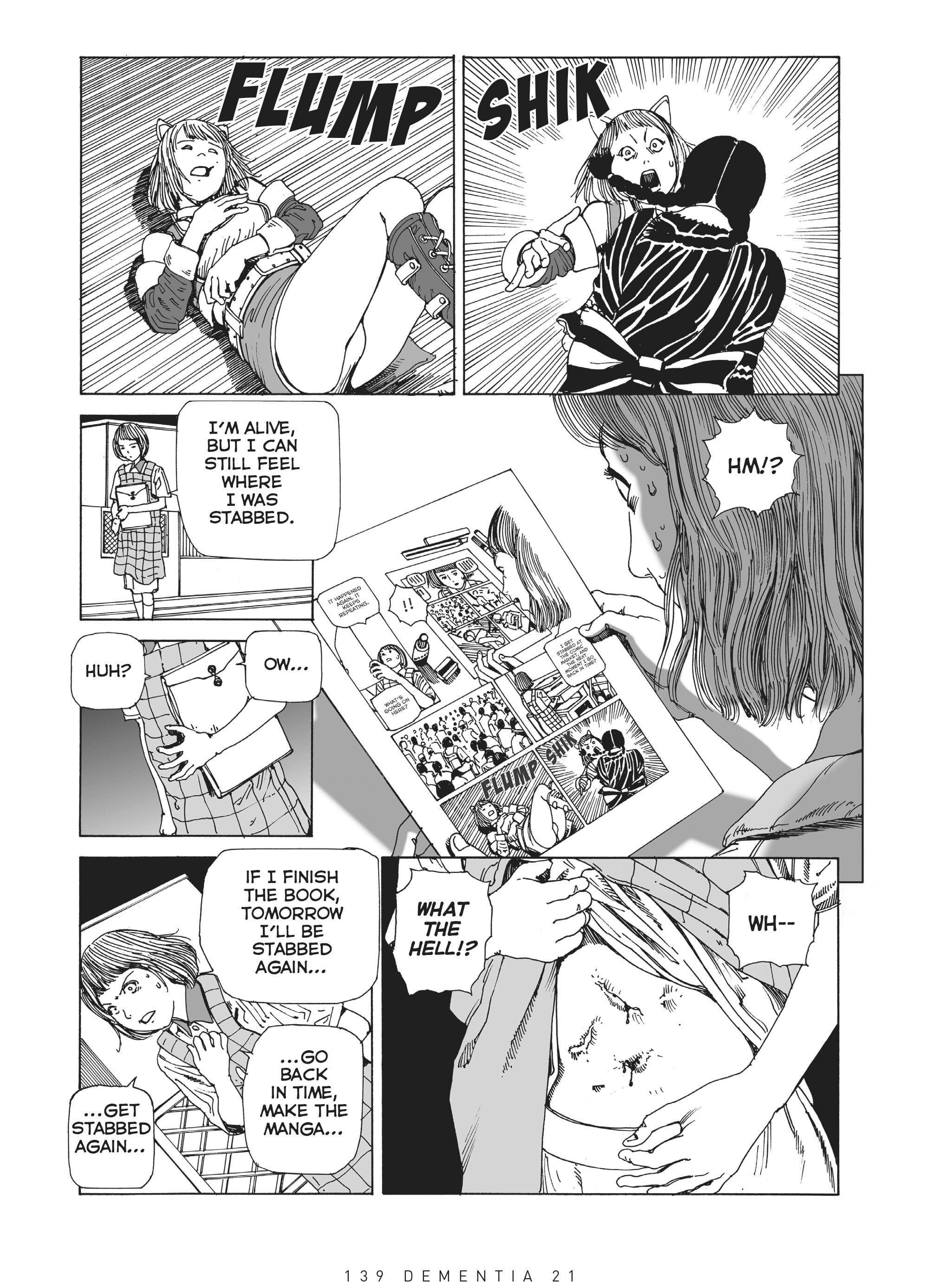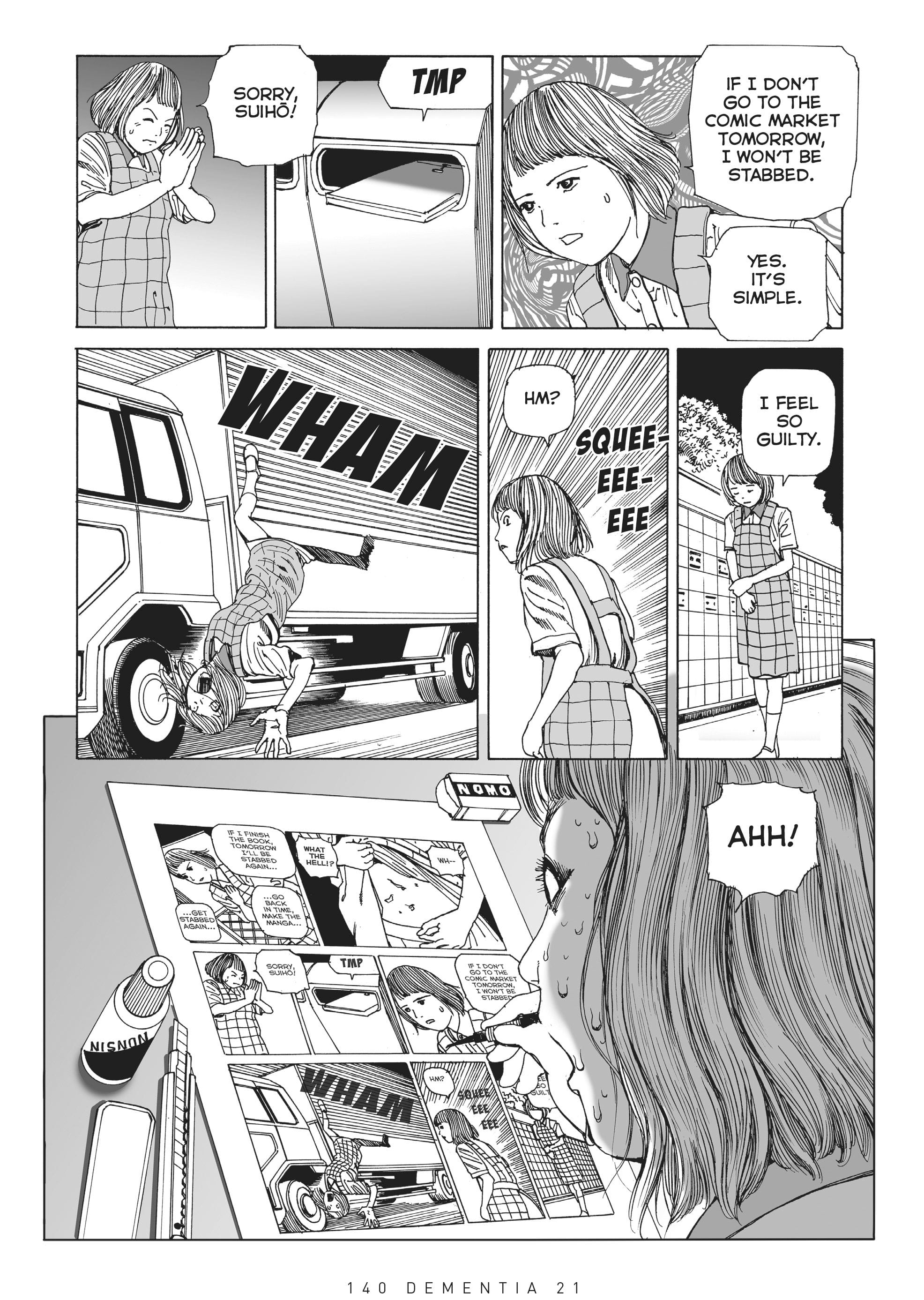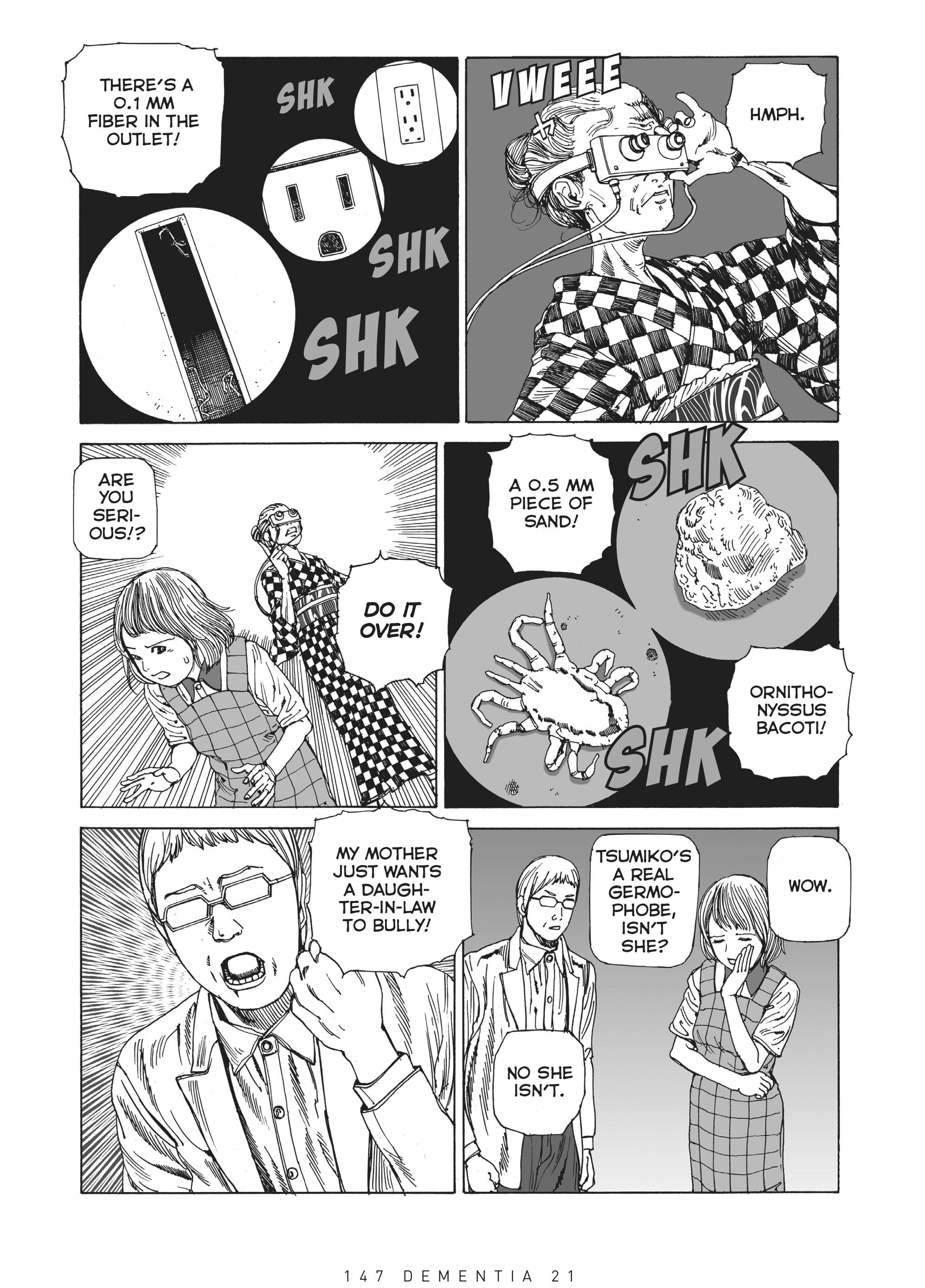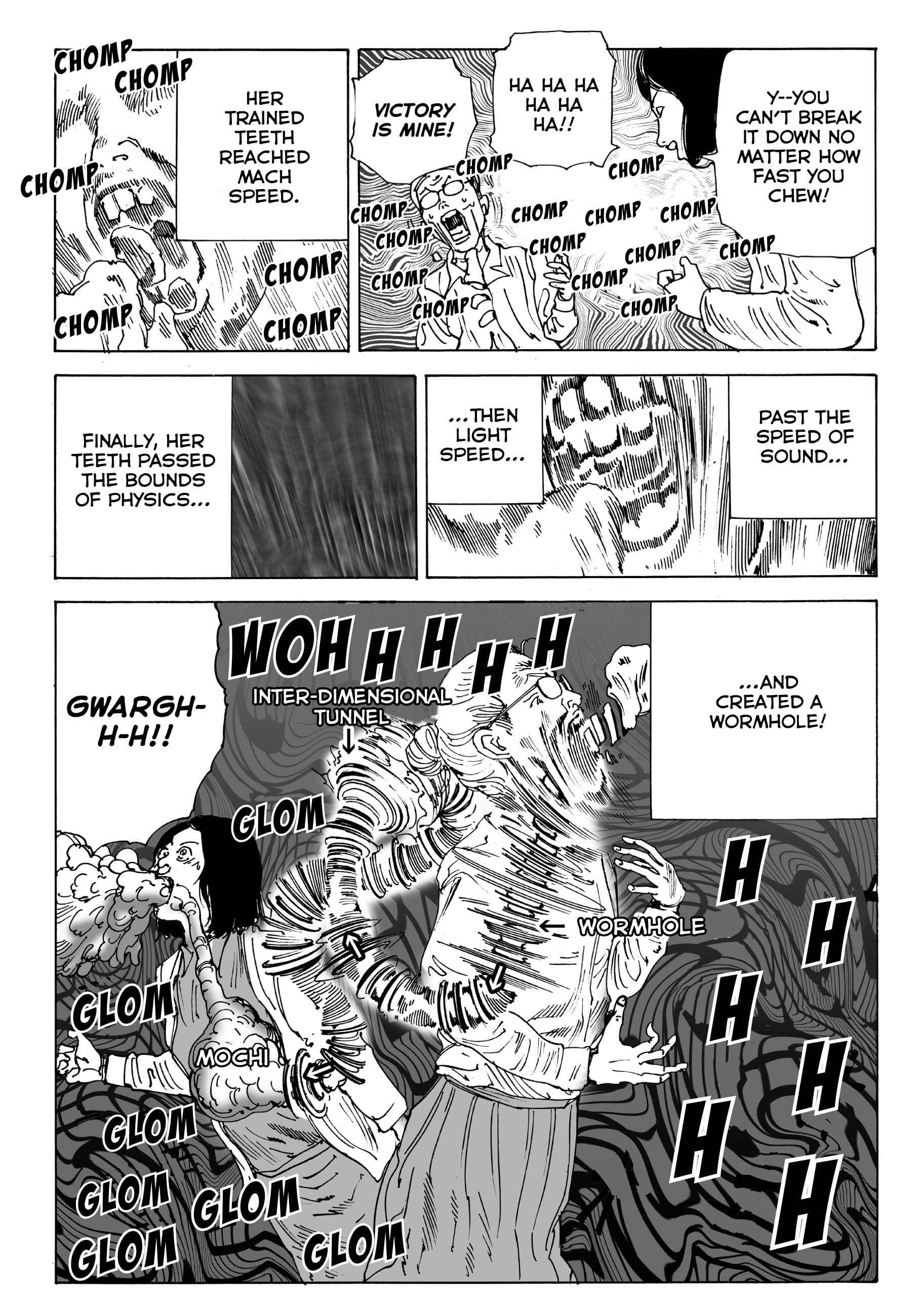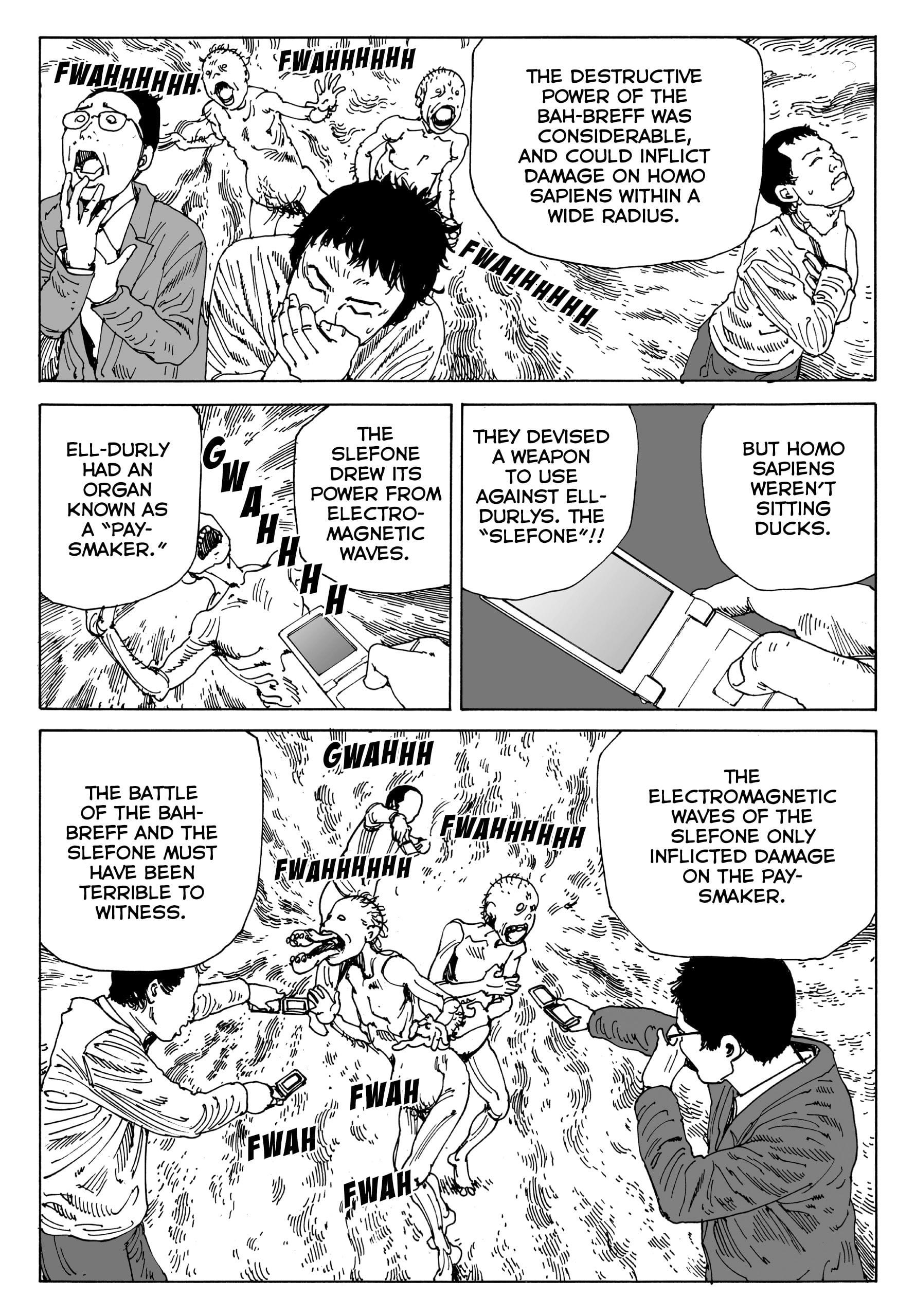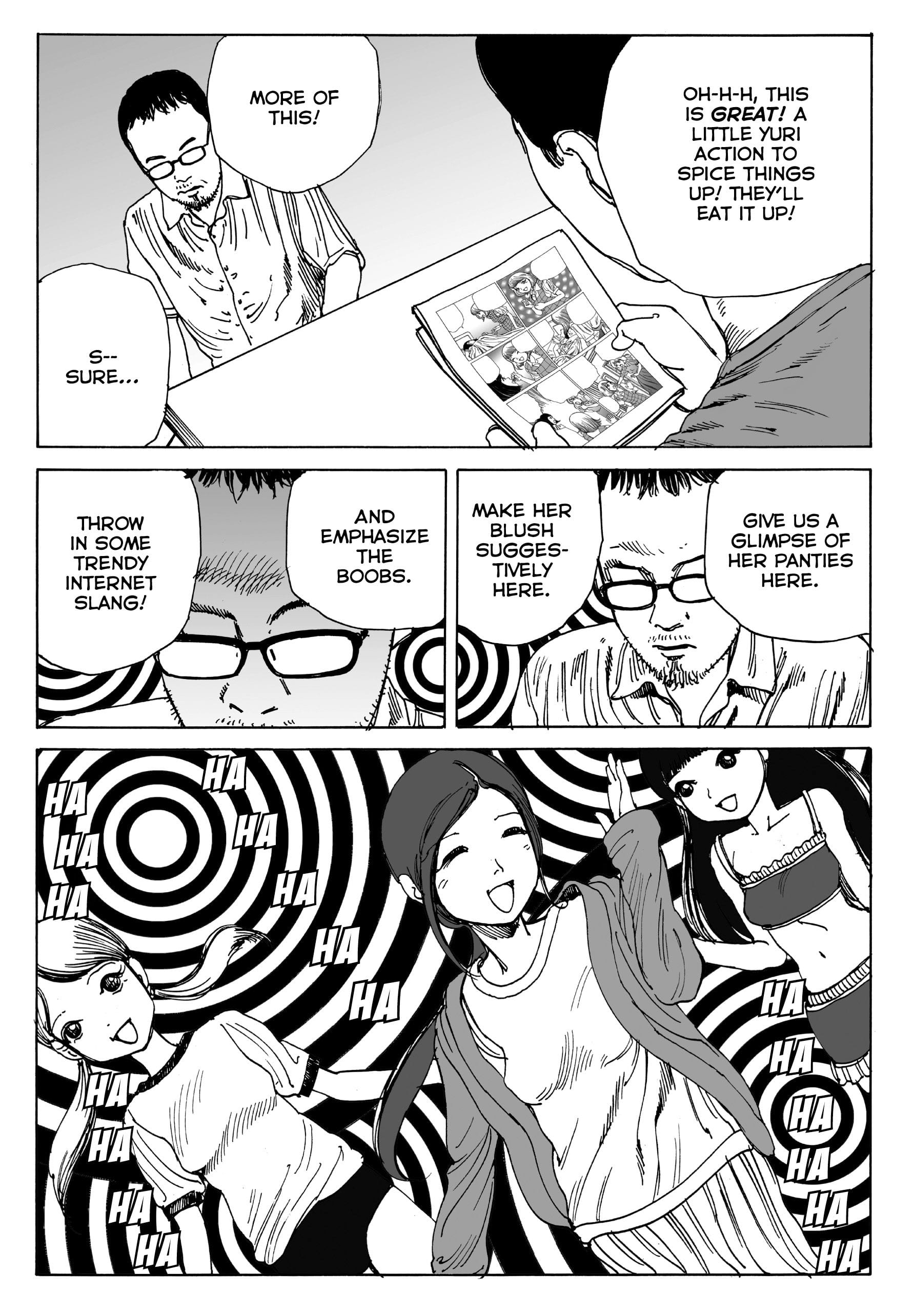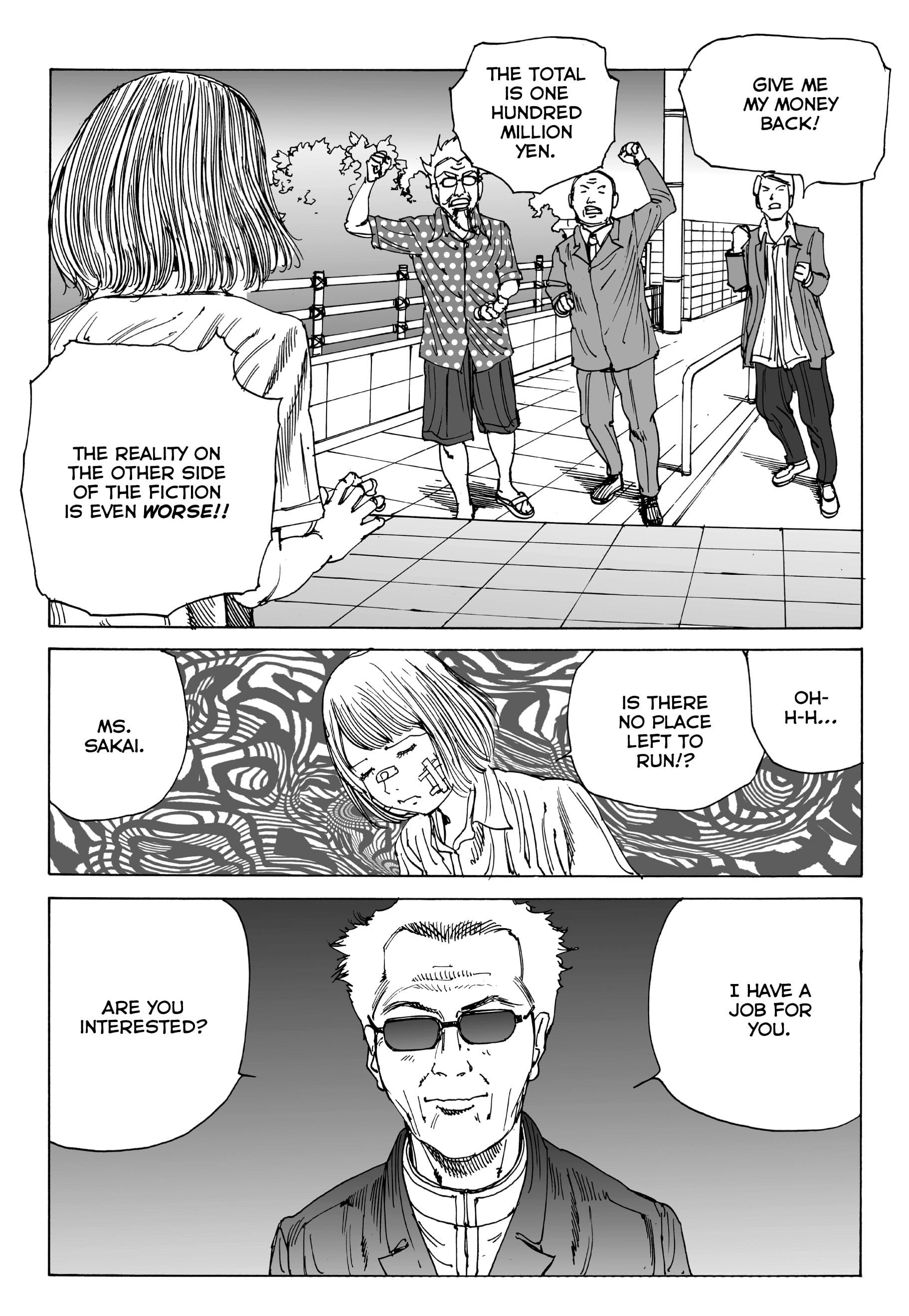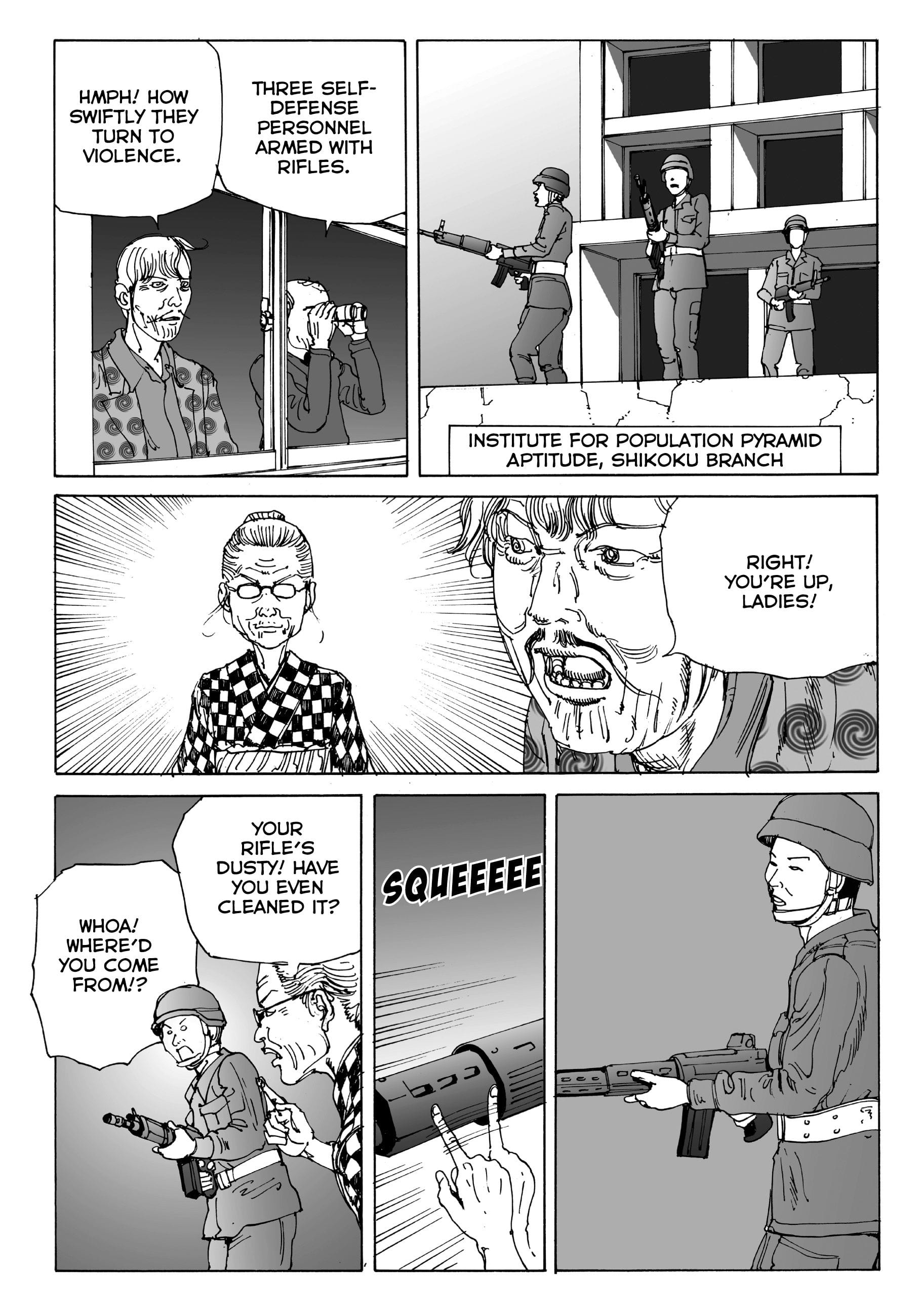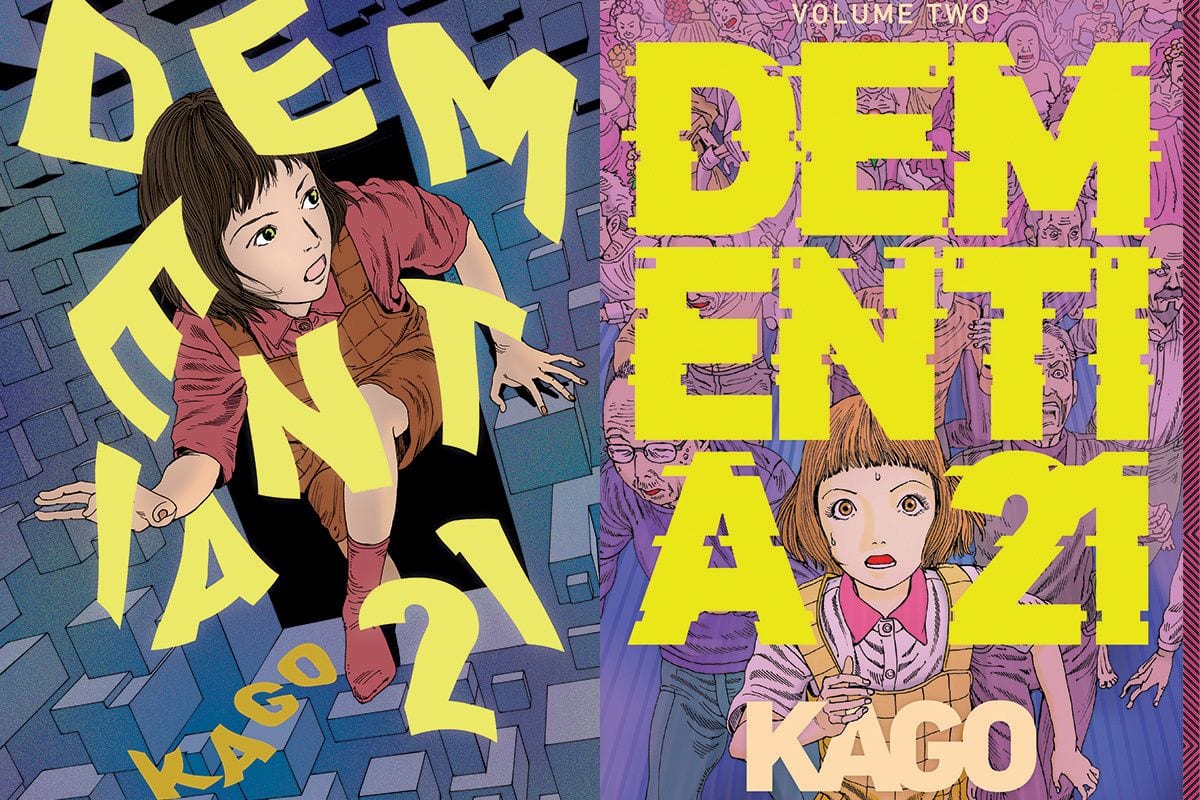
“I am Yukie Sakai, home help aide! And I’m here to help!!”
If that sounds like the tagline of a delightfully improbable superheroine, the crises that call her to action are even better. There’s a legion of brutal grandchildren hunting their destitute grandfather down for New Year’s change; a senile Santa Claus giving gangsters rocket-launchers for Christmas; an elderly woman whose supernatural dementia rewrites history to match her delusions.
This is the eldercare Twilight Zone of manga artist Shintaro Kago’s Dementia 21 now extended into its second volume for English readers. The first included an interview with the artist, as well as opening stories that provide some grounding. Yukie keeps getting these demented assignments because a jealous colleague is blackmailing an executive to destroy her. But since each episode stands alone, Volume Two does too.
As much as I admire Kago’s oddness as a writer, his artistic pen is even sharper. Unlike so many typical manga characters, Kago’s cast avoids the cliché stylistic ticks of their genre and instead hover at the edge of naturalism. Though selectively cartoonish, even when simplified, Yukie and her clients retain a realistic edge that intensifies their horror-tinged universe.
Kago wisely keeps his computer-generated graphics in the background, evoking the emotion of a moment through soft grays that swirl psychedelically or emanate in dramatic bursts. Best of all, the introductory page of each chapter—presumably covers or splash-pages for the original series—are surrealist mini-masterpieces.
(courtesy of Fantagraphics)
(courtesy of Fantagraphics)
(courtesy of Fantagraphics)
(courtesy of Fantagraphics)
(courtesy of Fantagraphics)
Though you might expect Yukie to defeat each episode’s menace, you can’t count on her. She reassured poor Mrs. Furuike that the zombies employed at the nursing home were no threat, but that didn’t stop the nursing home from attaching her head to machines and feeding the rest of her body to the new staff. When a neighborhood of condos designed to look like bingo boards plays an elaborate game of chance by darkening a square of windows whenever an elderly tenant dies, Yukie doesn’t even try to stop them. She’s equally powerless when Japan’s government passes a law nullifying all crimes committed by senior citizens to reduce over-crowded prisons—never mind that the elderly, deprived of the comforts of prison, “descended into more profound depths of evil.”
The English translation by Rachel Thorn provides an appropriately colloquial tone to the dialogue, including idioms (“All right, all right. I get the message. I’ll leave!”) and slang abbreviations (“Whadda we gonna, do, boss?”). The chapter set 10,000 years in the future must have been a particular challenge. The humor is primarily word-based with a chief archaeologist (a descendant and namesake of Yukie) lecturing about the discovery of an ancient species called the “Ell-durly” who battled ancient homo sapiens with repellent “Bah-breff” and detachable teeth. Adages are harder, requiring an asterisk and footnote to explain why the archaeologist thinks eggplants were poisonous (they were once thought to inhibit fertility and so lead to the saying: “Don’t let your daughter eat autumn eggplants”).
The core premise of the series requires some cultural context too. Presumably, a Japanese reader would know before the 16th chapter of the second volume that Japan has one of the highest elderly populations in the world: “I’m sure you’re aware that Japan’s population pyramid has become wildly distorted” with “increasingly more older people than younger people.” A heroine who works for a home aid corporation reflects that demographic fact and places all of the adventures in the realm of social commentary.
Unfortunately, no amount of cultural context can lessen Kago’s cavalier attitude toward rape. Yukie’s naked spirit is chased by the equally naked spirit of the inventor of a machine that forces out-of-body experiences: “Hi-de-ho! I may be old, but my disembodied spirit is as lively as ever.” Worse, according to the archaeologist’s theories, the male Ell-Durley “would attack a female homo sapiens … impregnate her … and keep her captive … while the fetus develops.” Worst of all, that demented Santa Claus rapes a child’s mother to fulfill the child’s wish for a baby brother. Dark or not, the humor doesn’t translate.
Still, Kago is significantly less sexually exploitative than the manga market he later lampoons. The collection dips fully into meta-fiction as Kago draws himself redrawing the series to satisfy the requirements of an anime producer. The changes replace Kago’s style with generic manga effects: Yukie’s “rounder face”, “bigger eyes”, “more exaggerated expressions!” That new version also includes “longer legs”, “shorter skirt”, and “big boobs”. Instead of old people, she’s caring for young girls. There are images of sponge baths and glimpses of panties.
(courtesy of Fantagraphics)
(courtesy of Fantagraphics)
(courtesy of Fantagraphics)
(courtesy of Fantagraphics)
(courtesy of Fantagraphics)
(courtesy of Fantagraphics)
Like most of the tales, the meta-Kago’s ends tragically, but this time the collection transitions into a four-part sequence that appears to bring the series to an end—not that any of Kago’s endings seem definitive. After Yukie tricks death by giving herself a 10,000-year lifespan, even the future archaeologist remarks on internal inconsistencies: “Wait, I thought I was supposed to be your descendant in this book.”
Other tales appear to exist in parallel realities. According to chapter three, Yukie and the rest of the cast are just actors in an elaborate stage production. Chapter six depicts a global war against a legion of supernaturally sentient diapers, until the entire planet is swaddled in one enormous diaper, which the human resistance causes to explode in confusion by intentionally urinating in their clothes. If that planet-wide cataclysm leaves any historical impression, it’s erased before the start of the next chapter, which itself ends with a child about to launch a world-ending nuclear missile strike.
The ending sequence brings a welcome arc to the series, initiating yet another war, this one between the elderly and the Japanese government attempting to exterminate them once and for all. Though I appreciate the extended storyline, it comes with the cost of Yukie, or at least her character consistency since the ever-kind aide transforms into a mercenary providing her talents and inside knowledge for a wad of cash.
The instant conversion is a cute gag, in keeping with Kago’s increasing meta-approach, but I preferred the old Yukie. Granted, she was first rendered destitute by the agency that recruits her, transforming her first into a vengeful monster kidnapping her former clients to discover who framed her and got her fired from her beloved job.
But maybe that’s all an alternative timeline too, and the lovable Yukie will return for a third volume?
- DEMENTIA 21 Vol.1 eBook: Shintaro Kago, Kei ... - Amazon.com
- Dementia 21 Vol.1 (9781683961062): Kago, Shintaro ... - Amazon.com
- Shintaro kago | Facebook
- Shintaro Kago: Books - Amazon.com
- Shintaro Kago - Wikipedia
- Dementia 21 Vol. 2 (9781683962816): Kago: Books - Amazon.com
- DEMENTIA 21 Book Series: Amazon.com
- New Releases :: Newly Available :: Dementia 21 Vol. 2


